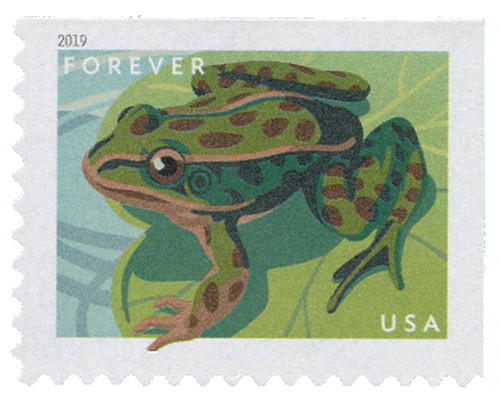
# 5395-98 - 2019 First-Class Forever Stamp - Frogs
US #5395-98
2019 Frogs
• Commemorates frogs of North America
Stamp Category: Commemorative
Value: 55¢ First Class Mail Rate (Forever)
First Day of Issue: July 9, 2019
First Day City: Boise, Idaho
Quantity Issued: 200,000,000
Printed by: Banknote Corporation of America
Printing Method: Offset
Format: Double-sided Booklet of 20
Tagging: Phosphor Tagged Paper, Block Tagged
Why the stamps were issued: To showcase the beauty and diversity of different North American frog species.
About the stamp designs: Pictures four digital illustrations of the Pacific tree frog, northern leopard frog, American green tree frog, and squirrel tree frog. Original artwork by Nancy Stahl consisting of shades of green and brown to represent how these frogs blend in with their native environments.
First Day City: The First Day of Issue Ceremony was held at the Morrison Knudsen Nature Center in Boise, Idaho.
History the stamp represents: Four frog stamps were issued by the USPS in 2019. They include the squirrel tree frog, northern leopard frog, American green tree frog, and Pacific chorus frog (formally known as the Pacific tree frog).
These amphibians have been around for millions of years. The oldest frog fossil ever found is known as Triadobatrachus and came from the Early Triassic Period. Surviving and adapting, this species has evolved into the frogs we know today.
Frogs are known to be an “indicator species.” This means when populations of frogs are prevalent in a certain area, the environment is healthy. Scientists believe frogs are susceptible to a poor ecosystem because they breathe through their skin. Furthermore, they spend their adolescent life in the water and their adult life on land, giving them dual exposure.
Frogs contribute to society in many ways. One way is by keeping the insect population under control. Frogs are also used for scientific research and pharmaceuticals in the medical field. From the toxins of dart frogs to the enzymes taken from northern leopard frogs, these amphibians could radically change treatments for some life-threatening types of diseases.
From stamps to medicine, frogs have many ways in which they are part of everyday life.
US #5395-98
2019 Frogs
• Commemorates frogs of North America
Stamp Category: Commemorative
Value: 55¢ First Class Mail Rate (Forever)
First Day of Issue: July 9, 2019
First Day City: Boise, Idaho
Quantity Issued: 200,000,000
Printed by: Banknote Corporation of America
Printing Method: Offset
Format: Double-sided Booklet of 20
Tagging: Phosphor Tagged Paper, Block Tagged
Why the stamps were issued: To showcase the beauty and diversity of different North American frog species.
About the stamp designs: Pictures four digital illustrations of the Pacific tree frog, northern leopard frog, American green tree frog, and squirrel tree frog. Original artwork by Nancy Stahl consisting of shades of green and brown to represent how these frogs blend in with their native environments.
First Day City: The First Day of Issue Ceremony was held at the Morrison Knudsen Nature Center in Boise, Idaho.
History the stamp represents: Four frog stamps were issued by the USPS in 2019. They include the squirrel tree frog, northern leopard frog, American green tree frog, and Pacific chorus frog (formally known as the Pacific tree frog).
These amphibians have been around for millions of years. The oldest frog fossil ever found is known as Triadobatrachus and came from the Early Triassic Period. Surviving and adapting, this species has evolved into the frogs we know today.
Frogs are known to be an “indicator species.” This means when populations of frogs are prevalent in a certain area, the environment is healthy. Scientists believe frogs are susceptible to a poor ecosystem because they breathe through their skin. Furthermore, they spend their adolescent life in the water and their adult life on land, giving them dual exposure.
Frogs contribute to society in many ways. One way is by keeping the insect population under control. Frogs are also used for scientific research and pharmaceuticals in the medical field. From the toxins of dart frogs to the enzymes taken from northern leopard frogs, these amphibians could radically change treatments for some life-threatening types of diseases.
From stamps to medicine, frogs have many ways in which they are part of everyday life.











